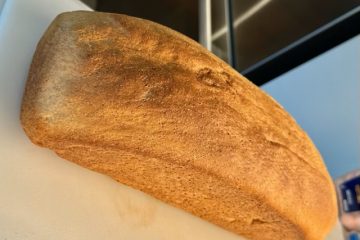Alarmed by his reading about the relationship between high fructose corn syrup (HFCS) and insulin resistance, Mr. F has embarked on a quest to eliminate HFCS from his life. We’re finding that this is way easier said than done. When Wikipedia describes HFCS as “ubiquitous,” they aren’t kidding. The stuff is everywhere.
Our first project was to find a replacement for what we fondly refer to as “tensies.” (You can tell we’re Lord of the Rings fans). A “tensie” chez Freberg is a mid-morning snack, and usually takes the form of a Fiber One bar, Nutrigrain bar, or Quaker oat bar. All run between 90 and 150 calories, and all, of course, list HFCS as a main ingredient.
A search among Internet recipes turned up a reasonable substitute. Our first efforts were tasty and satisfying. We ran the recipe through NutritionData.com, and it came out to be 127 calories per bar, well within our tensie range. Mr. F thought it was just a tad boring, so he plans to make smaller bars and add mini chocolate chips and nuts.
Unfortunately, we found that some of our ingredients were still problematic. Rice Krispies contain, you guessed it, HFCS, and so do the marshmallows. FiberOne cereal contains aspartame. I quit using aspartame years ago after a chemistry colleague told me that it was the likely cause of my dry, painful, and red eyes (I thought I was just reading too much). She was right. After I quit the aspartame, my eyes went back to normal. So we continue to hunt for alternatives to the Rice Krispies and FiberOne. I’m hoping the local New Frontiers has some HFCS/aspartame free choices. I’m not sure what to do with the marshmallows, although I think there are ways of making your own. We really wouldn’t need marshmallows in little squares, just the goo to hold the bars together.

Our First Effort at a Healthier Bar
For additional inspiration, we read the labels of some of our Jenny Craig products, and were surprised to find “corn syrup.” I’m a psychologist, not a food scientist, so we decided to do some snooping around regarding the similarites and differences between corn syrup and HFCS. It turns out that while both standard corn syrup and HFCS are made from corn, the former is mostly glucose while the latter is mostly fructose.

American Like Their Sweets
In 2005, the average American consumed nearly 30 kg (66 pounds) of HFCS, as corn is heavily subsidized by the federal government, making corn products unusually cheap. In addition to being suspected of contributing to America’s obesity epidemic, products containing HFCS also have high levels of reactive carbonyls not found in table sugar. Carbonyls have been implicated in tissue damage, such as nerve damage and foot ulcers, in diabetes.
Some food manufacturers are responding to concerns about HFCS, and are actually going back to good old sugar. I hope more do. I would definitely be willing to pay more. If I’m going to have something sweet, I’d rather have the real thing, and something that is unlikely to cause health problems. We’ll continue our quest for an HFCS-free bar, so stay tuned.


5 Comments
Cynthia1770 · August 11, 2009 at 8:28 am
Hi Laura,
My google alert for HFCS picked up your article. I’m interested in the study about the rat feds sucrose vs. HFCS.
What is the documentation? I’m afraid I couldn’t find the link.
Clif’s kid bars are HFCS-free (and tasty). I was surprised to find organic snack foods at a local Toys R Us store.
Try StopHFCS.com for an extenstive list of HFCS-free
foods and drinks. Good news: According to their CEO, Whole Foods is going to take the HFCS out. To To your health.
Laura Freberg · August 11, 2009 at 9:19 am
Hi, Cynthia.
Here it is: http://www.ebmonline.org/cgi/content/abstract/234/6/651
A key quote from the abstract is: “Of the different caloric sweeteners, only rats drinking HFCS-55 had greater (P < 0.05) final body weights and fat mass compared to the rats drinking ddH2O or glucose solution." Yes, this is a rat study, but when you read the scientific literature about HFCS, be sure to look at the fine print about the funding sources. If you need some help with this, just let me know. To healthy eating!
laurenshaber · February 11, 2010 at 9:58 am
I agree that a person should try to eliminate as much as they can to help them stay healthier. However, in today’s society, people base much of their food choices on convenience–packaged food and whatnot. Isn’t it true that these foods tend to have more unhealthy things in them such as high-fructose corn syrup? And soda? It’s full of aspartame, yet it’s easy purchase since it’s everywhere. It’s amazing to know that a family is trying so hard to eliminate these things, but it will be hard to convince the rest of the country to do the same thing.
Roger’s View of the World, Love and Seafood Gumbo! » what is making America fatter? you may be surprised · August 10, 2009 at 8:43 am
[…] Laura wrote a post a while ago with a link to a site that demonstrates that in two sets of animals given identical calorie diets, those fed high fructose corn syrup got obese and those with plain sugar did not. Here’s part of Laura’s enlightening blog: American Like Their Sweets […]
Roger’s View of the World, Love and Seafood Gumbo! » Something to relish at Del Monte · August 13, 2011 at 9:02 am
[…] My wife wrote a blog a few years back that shed some light on the phenomenon. Although data can sometimes be correlational and correlation does not equal causation, I think this issue deserves a fair hearing and I for one will not buy anything knowingly that contains HFCS. […]
Comments are closed.